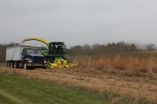(Press-News.org) Marginal lands – those unsuited for food crops – can serve as prime real estate for meeting the nation's alternative energy production goals.
In the current issue of Nature, a team of researchers led by Michigan State University shows that marginal lands represent a huge untapped resource to grow mixed species cellulosic biomass, plants grown specifically for fuel production, which could annually produce up to 5.5 billion gallons of ethanol in the Midwest alone.
"Understanding the environmental impact of widespread biofuel production is a major unanswered question both in the U.S. and worldwide," said Ilya Gelfand, lead author and MSU postdoctoral researcher. "We estimate that using marginal lands for growing cellulosic biomass crops could provide up to 215 gallons of ethanol per acre with substantial greenhouse gas mitigation."
The notion of making better use of marginal land has been around for nearly 15 years. However, this is the first study to provide an estimate for the greenhouse gas benefits as well as an assessment of the total potential for these lands to produce significant amounts of biomass, he added.
Focusing on 10 Midwest states, Great Lakes Bioenergy researchers from MSU and the Pacific Northwest National Laboratory used 20 years of data from MSU's Kellogg Biological Station LTER Site to characterize the comparative productivity and greenhouse gas impacts of different crops, including corn, poplar, alfalfa and old field vegetation.
They then used a supercomputer to identify and model biomass production that could grow enough feedstock to support a local biorefinery with a capacity of at least 24 million gallons per year. The final tally of 5.5 billion gallons of ethanol represents about 25 percent of Congress' 2022 cellulosic biofuels target, said Phil Robertson, co-author and MSU professor of crop, soil and microbial sciences.
"The value of marginal land for energy production has been long-speculated and often discounted," he said. "This study shows that these lands could make a major contribution to transportation energy needs while providing substantial climate and – if managed properly – conservation benefits."
This also is the first study to show that grasses and other non-woody plants that grow naturally on unmanaged lands are sufficiently productive to make ethanol production worthwhile. Conservative numbers were used in the study, and production efficiency could be increased by carefully selecting the mix of plant species, Robertson added.
"With conservation in mind, these marginal lands can be made productive for bioenergy production and, in so doing, contribute to avoid the conflict between food and fuel production," said Cesar Izaurralde, PNNL soil scientist and University of Maryland adjunct professor.
Additional benefits for using marginal lands include:
New revenue for farmers and other land owners
No indirect land-use effects, where land in another part of the globe is cleared to replace land lost here to food production
No carbon debt from land conversion if existing vegetation is used or if new perennial crops are planted directly into existing vegetation
INFORMATION:
The research was funded primarily by the Department of Energy's Great Lakes Bioenergy Research Center, the National Science Foundation and MSU AgBioResearch. Additional researchers from the Pacific Northwest National Laboratory and the University of Maryland contributed to this study.
Marginal lands are prime fuel source for alternative energy
2013-01-17
ELSE PRESS RELEASES FROM THIS DATE:
Scanning the brain: Scientists examine the impact of fMRI over the past 20 years
2013-01-17
Understanding the human brain is one of the greatest scientific quests of all time, but the available methods have been very limited until recently. The development of functional magnetic resonance imaging (fMRI) — a tool used to gauge real-time brain activity by measuring changes in blood flow — opened up an exciting new landscape for exploration.
Now, twenty years after the first fMRI study was published, a group of distinguished psychological scientists reflect on the contributions fMRI has made to our understanding of human thought. Their reflections are published ...
Immunology research sheds new light on cell function, response
2013-01-17
MANHATTAN, Kan. -- A Kansas State University-led study has uncovered new information that helps scientists better understand the complex workings of cells in the innate immune system. The findings may also lead to new avenues in disease control and prevention.
Philip Hardwidge, associate professor of diagnostic medicine and pathobiology, was the study's principal investigator. He and colleagues looked at the relationship between a bacterial protein and the innate immune system -- a system of defensive cells that responds rapidly to an infection in a nonspecific manner.
Among ...
NASA's Webb telescope team completes optical milestone
2013-01-17
GREENBELT, Md. -- Engineers working on NASA's James Webb Space Telescope met another milestone recently with they completed performance testing on the observatory's aft-optics subsystem at Ball Aerospace & Technologies Corp's facilities in Boulder, Colo. Ball is the principal subcontractor to Northrop Grumman for the optical technology and lightweight mirror system.
"Completing Aft Optics System performance testing is significant because it means all of the telescope's mirror systems are ready for integration and testing," said Lee Feinberg, NASA Optical Telescope Element ...
NASA sees 1 area of strength in Tropical Storm Emang
2013-01-17
Tropical Storm Emang continues to move through open waters in the Southern Indian Ocean and NASA's TRMM satellite noticed one area of heavy rainfall near the center.
On Jan. 16 at 0702 UTC (2:02 a.m. EST) NASA's Tropical Rainfall Measuring Mission (TRMM) satellite passed over Emang, and captured rainfall rates. TRMM identified that moderate rain was falling throughout most of the tropical cyclone, and heavy rainfall was occurring near the storm's center. TRMM estimated the heavy rain falling at a rate of 2 inches (50 mm) per hour.
On Jan. 16 at 0900 UTC (4 a.m. EST), ...
Gene in eye melanomas linked to good prognosis
2013-01-17
Melanomas that develop in the eye often are fatal. Now, scientists at Washington University School of Medicine in St. Louis report they have identified a mutated gene in melanoma tumors of the eye that appears to predict a good outcome.
The research is published in the advance online edition of Nature Genetics.
"We found mutations in a gene called SF3B1," says senior author Anne Bowcock, PhD, professor of genetics. "The good news is that these mutations develop in a distinct subtype of melanomas in the eye that are unlikely to spread and become deadly."
Eye tumors ...
Mayo Clinic: Skin problems, joint disorders top list of reasons people visit doctors
2013-01-17
ROCHESTER, Minn. -- A new Mayo Clinic Proceedings study shows that people most often visit their health care providers because of skin issues, joint disorders and back pain. Findings may help researchers focus efforts to determine better ways to prevent and treat these conditions in large groups of people.
"Much research already has focused on chronic conditions, which account for the majority of health care utilization and costs in middle-aged and older adults," says Jennifer St. Sauver, Ph.D., primary author of the study and member of the Population Health Program within ...
Eliminating or curtailing mortgage interest deduction would have modest long-run effects on economy
2013-01-17
Eliminating or curtailing the mortgage interest deduction (MID) would initially result in declines in housing prices and investment but would have only modest aggregate macroeconomic effects in the long run, according to a new paper from Rice University's Baker Institute for Public Policy.
The MID is the second-largest individual income tax expenditure, according to the congressional Joint Committee on Taxation. Given the severity of the fiscal problems currently faced by the U.S., many recent tax reform proposals have included measures that would curtail or eliminate ...
Recent study suggests bats are reservoir for ebola virus in Bangladesh
2013-01-17
NEW YORK – January 16, 2013 – EcoHealth Alliance, a nonprofit organization that focuses on local conservation and global health issues, released new research on Ebola virus in fruit bats in the peer reviewed journal, Emerging Infectious Diseases, a monthly publication by the Centers for Disease Control and Prevention (CDC). The study found Ebola virus antibodies circulating in ~4% of the 276 bats scientists screened in Bangladesh. These results suggest that Rousettus fruit bats are a reservoir for Ebola, or a new Ebola-like virus in South Asia. The study extends the range ...
Tree and human health may be linked
2013-01-17
Evidence is increasing from multiple scientific fields that exposure to the natural environment can improve human health. In a new study by the U.S. Forest Service, the presence of trees was associated with human health.
For Geoffrey Donovan, a research forester at the Forest Service's Pacific Northwest Research Station, and his colleagues, the loss of 100 million trees in the eastern and midwestern United States was an unprecedented opportunity to study the impact of a major change in the natural environment on human health.
In an analysis of 18 years of data from ...
PODEX experiment to reshape future of atmospheric science
2013-01-17
Satellite Earth science missions don't start at the launch pad or even in orbit. They start years before when scientists test their new ideas for instruments that promise to expand our view and understanding of the planet. NASA scientists and engineers are working now to lay the groundwork for the Aerosol-Cloud-Ecosystem (ACE) mission, a satellite that "will dramatically change what we can do from space to learn about clouds and aerosols," said ACE science lead David Starr of NASA's Goddard Space Flight Center in Greenbelt, Md.
How should the satellite's instruments be ...




